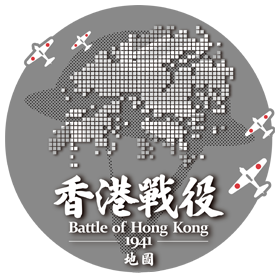Note on Structures
The interactive map includes the following military structures: Anti-Aircraft Gun Batteries and Coastal Gun Batteries, Barracks, Depots, Headquarters, Observation Posts, Pillboxes, Searchlight Positions, and Shelters. The following paragraphs explains the different functions of some of these structures.
1. Gun Batteries
During the Second World War, the static gun batteries in Hong Kong consisted of coastal gun batteries and anti-aircraft gun batteries. The former batteries were equipped with large-calibre guns that were designed to deal with enemy warships. Some of these guns could also traverse towards the inland and fire at enemy ground targets. After the outbreak of the war in Europe, the Hong Kong garrison built several emergency batteries that the Volunteers operated. As Hong Kong had only a few antiquated military aircraft, the local garrison had to rely on anti-aircraft gun batteries for air defence. The batteries were all linked with a central command with telephone lines, and the commander would try to disrupt enemy air formations by calling down barrages from one ore multiple batteries.
2. Barracks
In peacetime, the British garrison stayed in a number of major barracks on both sides of Victoria Harbour at Sham Shui Po, Tsim Sha Tsui (Whitfield), Gun Club Hill, Central (Victoria, Murray, and Wellington), and Lyemun. During the battle these barracks also became depots for various units, where the administration personnel often stayed.
3. Depots
According to the Defence Scheme the garrison prepared a number of major depots in Kowloon and Hong Kong Island. They were run by the Royal Army Service Corps and Royal Army Ordnance Corps personnel. A large vehicle pool was also established in the Race Course at Happy Valley.
4. Headquarters
During the Battle of Hong Kong, the general headquarters of the British garrison was located near modern-day Hong Kong Park. The underground command post below the Combined Headquarters was known as the “Battlebox”. The British also built command compounds for Brigade, Battalion, and Company levels along the Kowloon Ridge, in Kowloon, and on Hong Kong Island. Artillery Command Centres were also built on Hong Kong Island. Sometimes command posts were also set up in civilian buildings, such as Hunter’s Arms in Fanling and the Government quarters in Leighton Hill.
5. Observation Posts
When the British Army decided to build the Gin Drinker’s Line and concentrate all coastal defence batteries on Hong Kong Island during the 1930s, observation posts were built on the Gin Drinker’s Line and different parts of Hong Kong Island to direct battery fire – both directly and indirectly - to different targets. The Defence Scheme of 1941 suggests that there were 32 observation posts (including one coast watching station) in Hong Kong, excluding the observation posts of the fixed batteries. All these observation posts, except for the coast watching station that was operated by the Hong Kong Royal Naval Volunteer Reserve, were manned by the Royal Artillery.
These artillery observation posts look distinctly different from machine gun pillboxes in many key aspects. They are usually smaller in size (except for the observation post at Shing Mun), and their loopholes are significantly larger. Existing documentation about these observation posts are not as complete as that related to the pillboxes, but it can be seen from the Defence Scheme that although they were all artillery observation posts, they had different roles from ordinary ones, including “counter battery” and “flash spotting” roles. “Counter battery” and “flash spotting” observation posts were responsible for finding enemy artillery batteries and directing friendly artillery towards them. All these artillery observation posts were equipped with fixed landline communications to the various levels of artillery commands so that the central command could direct the guns – much like that on a warship, at least in theory. On Hong Kong Island, these artillery observation posts are all located on the mountains, but “high” and “low” level observation posts were located in certain parts of the Island because the line of sight of some mountains on the Island could be heavily obscured by dense fog.
6. Pillboxes
A Pillbox is a static defensive structure that allows defenders to operate machine guns the from within the protection of concrete walls. These structures are commonly known as a pillbox because it resembles a box used for storage of medicinal pills. It was known as “totsukaten” or “tochika” in Japanese, after the Russian pronunciation. In Hong Kong, pillboxes are usually found in mountain valleys and around the sides of beaches and other coastal positions. They were supported by other field positions to create a killing zone through crossfire. During the 1930s, the Hong Kong garrison had built around a hundred pillboxes along the Gin Drinker’s Line on Kowloon Ridge (ninety-four are found). Ninety-six more were built along the shoreline of Hong Kong Island and in the surrounding hills. After the war, the Hong Kong government demolished the pillboxes on the northern shore of Hong Kong Island. It was suggested that the pillboxes on the southern shore should also be demolished as they were considered as eyesores, but some were preserved as store facilities for beach workers.
7. Searchlight Positions
During the Second World War, there were three types of military searchlights in Hong Kong; these were “Coastal Defense Search Lights (CASLs)”, “Anti-Aircraft Search Lights (AASLs),” and “Lyon lights” of the pillboxes. According to Rob Weir, the CASLs in Hong Kong were mostly 90 cm in diameter; they were remotely controlled by the observation posts of the coastal gun batteries. The AASLs were directed by the Anti-Aircraft Command of the Royal Artillery in Hong Kong through fixed-line telephone communication. Usually, sappers and gunners, many of them Chinese, stood by the lights and were ready to assume manual control should this be necessary. The Lyon Lights were manually operated searchlights of 20-24 cm in diameter, housed in concrete searchlight positions near the pillboxes. Many of these searchlight positions were mistaken for pillboxes or artillery emplacements, but the former usually had only one embrasure, that was larger than those of the pillboxes. Except for the quick-firing guns near the Lyemun Redoubt, that were decommissioned before 1941, all coastal gun positions in Hong Kong were open type.
8. Shelters
Shelters are military facilities that protect soldiers when they are standing close to the frontline. Type-A shelters are the most commonly found type of shelters in Hong Kong. They are typically cement-built structures of around 2.75 meters in length, 3.65 meters in width, and 2.45 meters in height. The thickness of the walls is 30 centimetres. They usually have a steel door and a pair of steel window shutters. They can accommodate up to nine hammocks, and there are hooks for soldiers to hang webbing and other equipment. The primary function of the Type-A shelter is to provide accommodation and storage space for the garrison in the field. Due to humid weather conditions in Hong Kong, exposure of soldiers to this unsatisfactory living environment could affect morale and subsequent combat effectiveness. Thus, Type-A shelters can be found in different parts of Hong Kong. Some Type-A shelters were also used as command headquarters, storerooms, or shelters for mobile artillery positions. Most of the shelters are located within defensive localities, and there are usually pillboxes found nearby.



